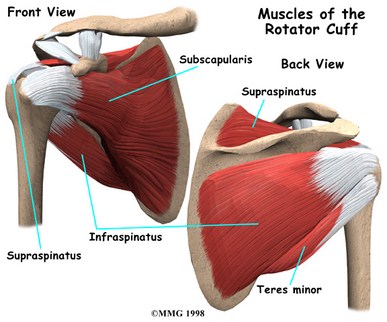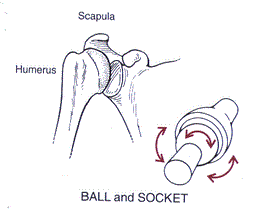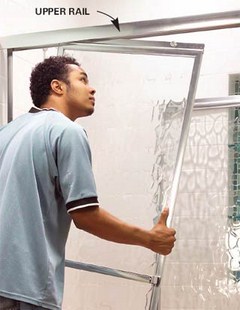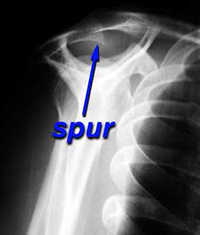 Last month I talked about shoulder impingement syndrome, a painful and debilitating condition that can make movement of the arm or shoulder excruciating. This month I want to talk about another shoulder injury I commonly see in my office, which is also, incidentally, the root cause of shoulder impingement syndrome, and that's rotator cuff syndrome. Last month I talked about shoulder impingement syndrome, a painful and debilitating condition that can make movement of the arm or shoulder excruciating. This month I want to talk about another shoulder injury I commonly see in my office, which is also, incidentally, the root cause of shoulder impingement syndrome, and that's rotator cuff syndrome.
For all intents and purposes, rotator cuff syndrome should be the foremost shoulder condition I speak of, because it truly is the root cause of many shoulder disorders—instability (which can lead to dislocation), bone spurs, and degeneration, which can ultimately lead to arthritis and frozen shoulder.
What is the Rotator Cuff?
So what is rotator cuff syndrome? To get a proper picture of this condition, it's important to understand the anatomy and function of the rotator cuff. The rotator cuff is a group of four muscles that sit around the shoulder joint in a cuff-like pattern. The names of the muscles are not important (if you care, study the picture below), but the function of the complex is. The rotator cuff attaches from the scapula, or shoulder blade, to the humerus, or arm bone, and it functions to pull the arm into the shoulder socket, stabilizing the arm, so that overhead movements can be performed.

As I mentioned last month, the shoulder is the most mobile of all the joints in the body. To attain mobility, the shoulder must sacrifice stability in the form of less ligamentous attachments. The shoulder, therefore, is primarily stabilized by the rotator cuff muscles.
What makes this so important is that if the rotator complex weakens in any capacity, be it from injury or deconditioning, the less able it will be to pull the arm firmly into the shoulder socket. The result is a less stable joint. With waning stability, several dysfunctions and concomitant symptoms can arise.
Weak and Painful Shoulder
The first dysfunction/symptom to arise is pain. When weak, the rotator cuff can no longer handle the load of raising (remember abduction?) and flexing the arm. Movements that elicit pain, and the ones I hear most often about in my office are:
- Reaching for a glass in the cupboard
- Reaching to switch on a light
- Putting on a seatbelt
- Washing one's hair
- Driving (steering) with the affected arm
The pain is also felt in a very distinct area, one that is classic for rotator cuff syndrome—the front of the shoulder. Disclosing this information is tricky; and I hesitate to do so, as I know it might cause confusion and a slew of self-misdiagnosis, but it is the classic sign of rotator cuff syndrome. What makes it tricky is that the pain is felt, and feels, and is described very similarly to biceps tendonitis, and to distinguish between the two takes a trained eye and accurate diagnosis. So I wouldn't use this information as a tool to diagnose one's own problem, but as a guide to tell you, “This isn't something to play around with; go see a sports chiropractor immediately.”
Snapping and Clicking Shoulder
The second dysfunction is snapping and clicking of the shoulder. Because movement of the shoulder joint depends on it sitting snugly in the shoulder socket, laxity in the rotator cuff muscles will disrupt the tracking of the joint. For lack of a better analogy—simply because the glenohumeral joint, or shoulder joint, is a ball and socket joint—but for the sake of my example I want you to think of a shower or closet door that rolls on a track. If the wheels of that door come slightly off the track, the door will be harder to open and close—we call that a tracking problem. The same is true of the shoulder joint; when unstable it will also have a tracking problem and will rub and scrape the joint surfaces causing a wearing away of the tissue. This wearing away is known as degeneration, which causes arthritis.

 Arthritis or inflammation of a joint is not only painful, but the body sees it as something that needs to be fixed. Because an arthritic joint is unstable, the body will try to create stability by fusing the joint. Not a good thing, fusion. When full fusion occurs, forget motion, the joint will be forever cemented. But this takes a long time and lots of neglect. More likely, though, only the beginning of the fusion process occurs—the formation of bone spurs. Spurs form as small protrusions growing outward from the bone that eventually hook in a direction which will eventually allow it to cross the joint it is attempting to fuse. Freaky, right?—shows you the incredible intelligence of the human body. In any case, bone spurs can create a whole slew of problems including pain, nerve impingement, decreased range of motion, and even muscular tears and scarring.

Frozen Shoulder
The third dysfunction is scarring of the shoulder joint. Remember that the body sees instability as an injury, and as a result tries to stabilize the joint. Often the body does this by laying down scar tissue. Scar tissue is a very strong, fibrous substance that prevents movement by the way its fibers are laid down. Whereas muscle and tendon tissue are striated—that is, the bands lay in the same plane (tear a piece of chicken to observe striated strands)—scar tissue is laid down haphazardly, in many directions, like a spider's web. The criss-crossing of fibers adds strength and ultimately stability. Now this is what we want if we, say, dislocate our shoulder—a little extra added stability. But in a merely dysfunctional joint, like one that has a weak rotator cuff, you don't want scarring to occur. People who develop scarring will start by having pain and very limited movement. But the pain gets worse as the range of motion decreases, which continues to diminish as scar tissue formation persists. This syndrome is very painful, and if it gets bad enough, it requires surgery. It's called frozen shoulder.
Treatment of Rotator Cuff Syndrome
So…rotator cuff pain and weakness, shoulder instability, degeneration, bone spur formation, arthritis, and frozen shoulder ( sheesh! ) all together make up rotator cuff syndrome. How can we remedy and prevent all this from happening? Well the first step is to get properly evaluated. I know I make it all sound so easy, but it really does take knowledge, understanding, and experience. There are so many different shoulder problems that can cause similar symptom, each of which requires a different type of treatment and protocol. And, mind you, time is of the essence; so the longer shoulder problems persist, the tougher they are to treat, and often, the less desirable the outcome. To get your shoulder problem properly evaluated, you really need to visit your local sports chiropractor. Although I love all my chiropractic sisters and brothers, not all chiropractors work in the same way. And in regard to shoulder injuries, you'll want a doc who's qualified and focused on sports injuries—like moi!
A Certified Chiropractic Sports Physician accredited with the American Chiropractic Board of Sports Physicians is truly the best practitioner to help you with your non-surgical shoulder rehabilitation. And rehab is exactly what you'll need. Rotator cuff rehabilitation is very similar to the rehab we talked about last month for shoulder impingement. You'll need to have adhesions and scar tissue broken up. You'll need to reduce inflammation with ice. You'll need to stretch tight and restrictive muscles. And you'll need to strengthen weak shoulder, upper back and neck muscles in a specifically designed routine and protocol, to insure the best and most comprehensive healing of your shoulder. And, of course, you'll need to be adjusted, so that your spine has proper movement and freedom throughout the treatment time. Of course, the removal of any nerve function impedance is also critical in enhancing the healing process, and this will be accomplished through the powerful and effective chiropractic adjustment. Along with that, drinking lots of water, taking the proper nutritional support, and getting lots of rest will be of the utmost importance.
So if you are having shoulder pain and weakness that doesn't seem to be getting better, but feels worse week after week, then visit your local Sports Chiropractor. If you happen to reside in or near the Los Angles, Beverly Hills or West Hollywood areas, then come see me—we'll get your rotator cuff back up and functional in the shortest amount of time possible. With that, happy lifting!
- July 31, 2008
*NOW AVAILABLE
The Six Keys to Optimal Health by Dr. Nicolas Campos
For More Advice on Health and Optimal Living Read
The Six Keys to Optimal Health by Dr. Nicolas Campos

|

















